Drawings By New York- Kate Jackson
The New-York Historical Society
Drawn By New York Exhibit
An exhibit of art by New York artists. Some of the art features scenes from New York, while others depict different views. The New-York Historical Society is a more intimate venue for these paintings, and is entirely less crowded than the other, more popular museums.
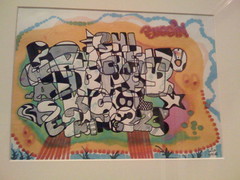

Tracy 182- Graffiti artist, drew inspiration from impressionism, inspired many young artists to pick up the spray can. Images of his “buggin” and “tracy 182″ are done in wildstyle. Originally from the Bronx, he was part of the conception of graffiti. His art is said to resemble the work of German Expressionist Paul Klee, Abstract Expressionist Franz Kline, and Islamic calligraphy. This raises issues on the ethical, emotional, and artists aspects inherent in a bold art that is prominently displayed on other people’s property.



Eve Aschhiem- Strange Water 1999-200, Water III 1996, Water VII 1997- belongs to Aschhiem’s Water Series, a collection of 200 drawings of the Hudson River. Aschhiem obsessively studied water patterns, bringing the Hudson School of American Art into the modern age. Her paintings have no color, yet evoke the sensation and memory of water with the play of light between dark and white, creating unsettled and fluid images. Her work also reflects the words of Heraclitus, in that one cannot step into the same water twice. Aschhiem’s drawings? sketches? paintings? clearly show the wisdom of these words: the water she draws from her studio (repeatedly) never looks the same. There’s something about her images that captures the eye, something undoubtedly liquid despite her monotone color scheme.
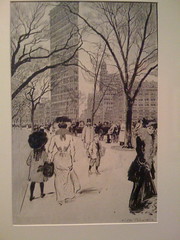
Victor Semon Perard- The Flatiron Building: Fifth Avenue and Madison Square, New York, 1907: coming on the heels of Hassam’s New York and the different between imitation and creation, this black and white sketch of the Flatiron Building caught my eye. Deceptively simple, yet eye-catching, this pen & ink sketch shows a woman from behind, dressed in period fashion, walking towards the uniquely-shaped Flatiron Building in the background. Various other bystanders function in the sketch, but the eye is immediately drawn towards the women, and the building that echoes her upright posture. It is possible that the artist sought to contrast her curves and femininity against the phallic symbol of the building, and if so, he was successful.
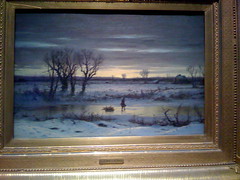
George Henry Boughton: Winter Twilight Near Albany, New York, 1858: icy and desolate, this picture immediately stood out amongst its warmly painted and pastoral fellows. Although pastoral itself in theme, the painting shows a bleak and harsh winter landscape, with scrubby and barren trees, a frozen-over creek, and a little boy dragging firewood along in an overburdened sled. The scene is forbidding; the low-hanging and bruised clouds threaten more snow (undoubtedly why the boy is stocking up on wood). What drew me to this picture is that it doesn’t show the unadorned natural charm of winter, or the rosy picture man would make of it-it shows a single human silhouetted against the dying sun in a dead and frozen waste, and the harsh beauty within it.

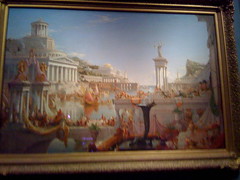
 Thomas Cole: Empire Series: in these three large canvasses, Cole depicts the rise and fall of an Empire. Apparently it was originally created as a cautionary tale for those who would build America into an empire. The first two paintings are a mishmash of great Empires, poorly combined and cluttered despite the skill that went into making them. The last canvas, showing nature’s reclamation and purification of the Empire’s corrupted remains, is striking-the decaying marble edifices, slowly being overgrown with moss and vines, are a warning to how fragile society is, and a cautionary tale for any would-be Caesars.
Thomas Cole: Empire Series: in these three large canvasses, Cole depicts the rise and fall of an Empire. Apparently it was originally created as a cautionary tale for those who would build America into an empire. The first two paintings are a mishmash of great Empires, poorly combined and cluttered despite the skill that went into making them. The last canvas, showing nature’s reclamation and purification of the Empire’s corrupted remains, is striking-the decaying marble edifices, slowly being overgrown with moss and vines, are a warning to how fragile society is, and a cautionary tale for any would-be Caesars.
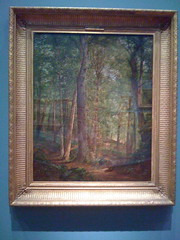
William Trost Richards: June Woods (Germantown), 1864: set in a gallery full of artificially contrived and composed landscapes, the wild, unplanned tangle of Richards’ June Woods is a refreshing and captivating break. Torn between the false landscapes of the Hudson School and critic John Ruskin’s call for absolute artistic fidelity, Richards struck a balance, painting nature, but as he saw it, not as how it was expected to be presented. The scene is a confusion of foliage and undergrowth, riven with winding paths probably made by the hooves of deer. The scene is infused with light and warm, sunlight filtering through the trees above.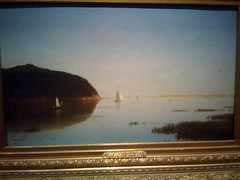
John Frederick Kensett: Shrewsbury River, New Jersey, 1859: a pastoral and planned landscape, this painting shows a panoramic view of the Shrewsbury River. The marshy expanse of water is dotted with the billowing canvas of sailboats, and the only delineation between sky and river is the shore and a frosting of golden reeds across the horizon of the water. Although true to the Hudson School’s depiction of idealized views, this painting isn’t too far from the true, and has a resonance and light to it.
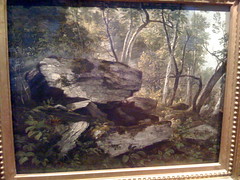
Thomas Hiram Hotchkiss: Catskill Mountains, New York, 1858: this canvas depicts a lifelike outcropping of stone surrounded by saplings and young forest growth. It is a more naturalistic and unplanned depiction of a landscape then typical of the Hudson School artists, which is probably why it’s more interesting-the jumble of rocks and stones create a more intriguing image than that of a staged pastoral scene.
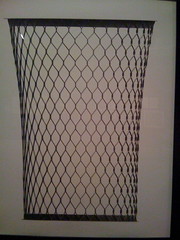
Edward Andrew Zega, Bernd H. Dams: Wire Trash Basket, 2003: Zega and Dams take something as utilitarian as one of the trash baskets common throughout Central Park, and make viewers look at it in a new light. Seen without the distracting back half of the basket, their life-size pen and charcoal drawing pays homage to the unexpected beauty of the ordinary. Their drawing was produced as part of an exhibit celebrating Central Park’s 150th birthday. The baskets themselves are manufactured by Corcraft Products of the New York State Department of Correctional services, a.k.a. New York State’s female inmates. The cans themselves will slowly be replaced. Despite their beauty, they are less than functional and easily crushable. Zega and Dams take a moment to remind New Yorkers to appreciate their trash receptacles before they disappear.
If any of the photos don’t work, they’re also on a Flickr account under katej0530@yahoo.com [http://www.flickr.com/people/32380076@N04/]
Comments
Leave a Reply
You must be logged in to post a comment.


